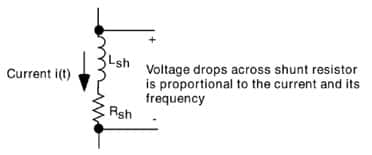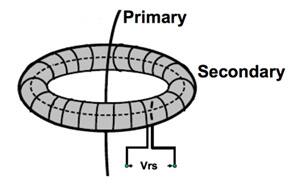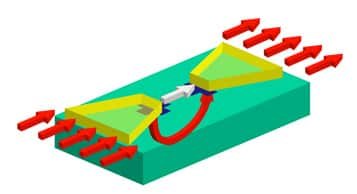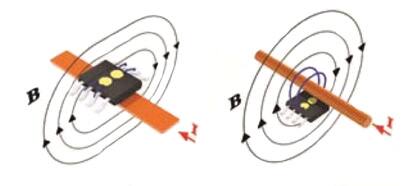Efficient Measurement of Electrical Power on the Smart Grid
投稿人:DigiKey 欧洲编辑
2013-10-29
Devices needed on the smart grid, such as utility meters and renewable-energy and appliance-monitoring systems, need to sense the consumption of energy accurately. A number of techniques have been developed that allow efficient measurement of electrical power, each having its own strengths and weaknesses. This article looks at current transformers, Rogowski coils, Hall-Effect sensors, and resistive shunts as options for energy measurement.
The amount of energy that electrical devices consume has become such a major concern that it is driving large government programs such as the UK’s smart meter rollout, which is due to start in earnest in less than two years. Each electrical smart meter demands an accurate way of determining current draw. That need is extending to a growing range of systems that will be hooked up to the smart grid, such as renewable energy sources and white-goods appliances and data-center computers, so that users can keep track of their energy usage.
In the data center, business users want to be able to use real-time power usage information of individual machines or racks to guide how jobs should be distributed across them. In the home, users can monitor significant energy consumers and have them automatically disabled or stalled during high-tariff periods. The question that faces the designers of the power sensors is which technology best suits the application.
There are four basic types of sensor technology that help determine electrical energy: current transformers, Rogowski coils, resistive shunts, and Hall-Effect sensors. Which one needs to be used depends on the deployment, whether the site takes electricity from a single phase, split phases, or from all three phases employed by the distribution system.
Homes in the US usually have a split-phase power feed that delivers either 120 VAC or 240 VAC. This architecture generally calls for a current transformer as the energy sensor. Commercial and larger residential sites in Europe use a three-phase supply. Individual homes are usually single-phase, which can allow meter implementation using a simple shunt-resistor sensor. The three-phase systems will either employ a current transformer or Rogowski coil, the latter traditionally being more suitable for larger installations.
The current shunt is the simplest and cheapest option as it is simply a low-value resistor placed on the electrical connection from the utility to the premises. The voltage drop across the shunt resistor is proportional to the current and its frequency. However, this simple setup has drawbacks. The current shunt itself needs to be large in order to handle the high currents inherent in the mains supply. Even then, self-heating and the amount of energy it draws can be problematic, which is why these shunts tend to be used for smaller domestic installations.
To limit the power drawn off, the current shunt should have a resistance measured in hundreds of micro-ohms. As a result, the signal-conditioning circuitry used to sense the voltage drop has to deal with comparatively small values, often less than 10 µV, demanding the use of sensitive op-amps to boost the signal.
Parasitic inductance can also introduce a significant phase shift at low power factors that is enough to cause large measurement errors. However, this problem has been ameliorated somewhat by regulations that are designed to maintain high power factors.

Figure 1: The principle of a current shunt.
Some resistors are designed to be used for current sensing, employing the ‘Kelvin’ configuration, such as the high-power TGHG series from Ohmite, optimized for precision sensing and the low-power LVK series. These are resistors with four terminals, enabling a current to be applied through two opposite leads and a sensing voltage to be measured across the other two leads. The Kelvin configuration effectively eliminates the resistance and temperature coefficient of the leads, helping to maintain accuracy in the absence of large voltage drops.
For use in multiple-phase situations, current shunts require isolation, but they have the benefit of being reasonably immune to tampering through the use of strong magnetic fields, which affect some of the other current-measurement techniques. As a result of its low cost, the current shunt is likely to find use in non-utility meters designed to measure the energy consumption of devices powered from the grid in the home or office.
Optocouplers provide a means to build isolation into the circuitry. To simplify the task of isolation, Analog Devices offers the iCoupler series. These are integrated transformers built on top of a CMOS substrate that, in the case of the isoPower members of the family, includes transformers to couple power to the other side of the isolation barrier. This removes the need to build separate power supplies into either side of the barrier.
A sensor with built-in isolation is the current transformer. This has a primary-winding magnetic core, which is generally made of iron, and a secondary winding. The AC that flows in the primary produces a magnetic field in the core that induces an AC in the secondary that can be measured by the circuitry to which it is attached. For utility meters, the normal form of current transformer is the window-type, such as the AC1050 from Talema Group. With a window-type transformer, the conductor passes through the center of the iron core, providing a single-turn winding.
Current transformers typically have a small phase distortion that requires compensation, especially when applications require more sophisticated measurements, such as reactive- and harmonic-energy measurements. However, the current transformer normally provides accurate current readings and is suitable for high-current systems, as it does not suffer from the self-heating effects of a current shunt.
There are drawbacks with the current transformer. The conductor has to be separated so that the current sensor can be slid onto it, which complicates installation. The core is also susceptible to tampering by powerful permanent magnets. By saturating the iron core, a user can ensure that the sensing coil does not pick up the AC field generated by the power line. The Rogowski coil avoids the problem of iron-core saturation by employing an air core, which does not saturate in the presence of a powerful external magnetic field. A further advantage of the Rogowski coil is that it does not need direct contact with the conductor, the coil simply needs to wrap around the conductor.
The output of the Rogowski-coil current sensor is proportional to the first derivative of the AC current that passes through it. As a result, the output of the sensor needs to be integrated before it can be multiplied by the primary voltage to provide a power reading. Because of this, the Rogowski coil cannot substitute directly for a current transformer, as the signal-conditioning electronics need to provide the integration function. The engineer has a choice of whether to use analog integration, typically based on an op-amp circuit, or digital integration.

Figure 2: Schematic of a Rogowski coil.
Digital processing provides reliable performance over the long operating life required of a typical smart meter and overcomes the problems that analog components have with drift over time and temperature, which will result in large measurement error. Furthermore, analog components can introduce a slight phase variation that requires phase calibration. A digital integrator has consistent and accurate phase response. The falling cost and power consumption of high-speed 32-bit microprocessors is making digital integration increasingly feasible and it is possible that a single meter design might be made compatible with either current transformers or Rogowski coils by using a software switch, and accepting the slightly-higher processing load of the integration function.
Although Rogowski coils are not susceptible to tampering in the same manner as current transformers, there are ways in which the signal can be affected if remedial measures are not taken. The coil itself is affected by external magnetic fields that can cause erroneous readings. However, careful design of the coil to cancel out the field is generally effective against magnetic tampering. Another mechanism for influencing the sensor is to use inductive coupling. Faraday cages can be used to protect against this situation as well as blocking the effects of capacitive coupling.
A small capacitance exists between the current sensor secondary winding and the conductor or busbar going through it. If the busbar has a high voltage potential, which is the case for grid supplies, an AC signal will be passed through this small capacitance and affect the output of the current sensor. Placing a metal shield around the current sensor reduces this effect, but does not necessarily eliminate it completely. Current sensors manufactured by Pulse Electronics, such as the PA320XNL series, use a specially-designed Faraday shield that is in very close proximity to the secondary winding. The shield prevents the AC signal of the high-voltage busbar from affecting the output, eliminating the effects of capacitive coupling.
In contrast to current transformers, Rogowski-coil sensors can be made open ended. As they have no metal core, they can be made in two sections, with a hinge, and clamped onto a conductor instead of the conductor needing to be separated so that it can be passed through the center of the current sensor. There are many possibilities for different shapes and sizes, allowing ready use with busbars as well as round conductors.
A further non-contact solution is the Hall-Effect sensor, although this does not typically offer the high accuracy of the shunt resistor, current transformer, or Rogowski coil. As a result, Hall-Effect sensors tend to find less use in utility meters where accurate billing is essential. However, they are finding applications in smart-grid applications where they make suitable, easy-to-apply sensors for appliance-level energy monitoring, and analyzing the efficiency of power systems in data centers or for analyzing the performance of renewable-energy systems.
Being contactless like the Rogowski coil or current transformer, Hall-Effect sensors do not require galvanic isolation. The Hall-Effect sensors also provide a direct current reading in contrast to the derivative provided by Rogowski coils. Being electronic in nature, they are beginning to take advantage of integration to preprocess the signal to bring it into the range of a typical microcontroller’s A/D converter.

Figure 3: An IMC structure focuses the magnetic field flux onto the Hall-Effect elements in an integrated sensor.
The MLX91205 from Melexis is an example of a Hall-Effect sensor designed to be easy to assemble close to a conductor. A standard CMOS process is used to make the current sensor. The additional ferromagnetic layer, also known as the integrated magnetic concentrator (IMC), is added in a simple post-processing step. The ferromagnetic layer amplifies the magnetic field and concentrates it on the Hall elements. The IMC itself consists of a highly-permeable, low-coercive-field, amorphous ferromagnetic layer directly bonded onto the Hall sensor chip’s surface. An IMC works to concentrate the magnetic field flux lines onto the Hall elements, which are about one-tenth the size of IMC.
The two parts of the IMC collect and amplify the small magnetic flux parallel to the chip surface and locally rotate the in-plane component into a magnetic field perpendicular to the chip’s surface. Whereas a conventional Hall sensor is sensitive to a magnetic field perpendicular to its surface, the IMC-Hall sensor is sensitive to a magnetic field parallel to its surface.
The IMC-Hall sensor is packaged in a standard plastic SOIC-8 package so that it can be mounted onto a printed circuit board (PCB) using standard pick-and-place machines, and soldered using conventional soldering techniques. The measured current is sent either directly through a current track of the PCB located under the sensor, or the sensor can be mounted a small distance underneath the current conductor.

The sensor’s current range is limited by the geometry of the conductor and the shield. The current range may be increased easily by increasing either the cross-section of the busbar or the distance between the sensor and current conductor. The sensor can monitor currents from 5 A to 100 A on PCBs or up to 1000 A on busbars.
As the Hall-Effect technology develops and is combined with on-chip processing, we can expect the accuracy and power handling to improve over time, providing more options to system designers as power measurement becomes more prevalent.

免责声明:各个作者和/或论坛参与者在本网站发表的观点、看法和意见不代表 DigiKey 的观点、看法和意见,也不代表 DigiKey 官方政策。









 中国
中国